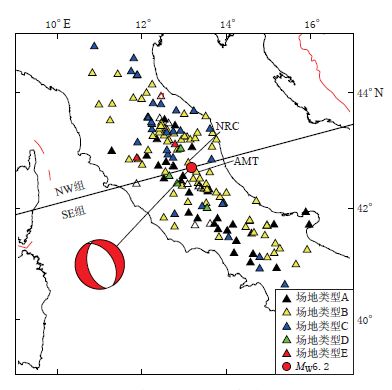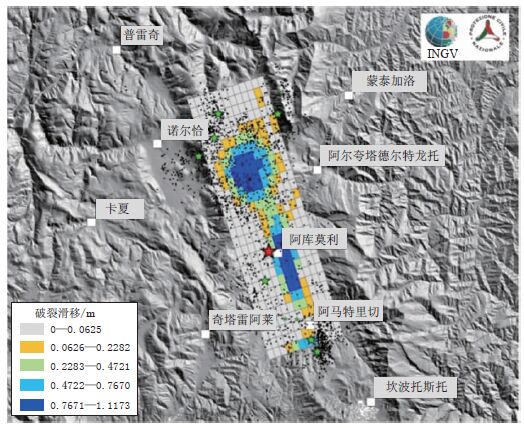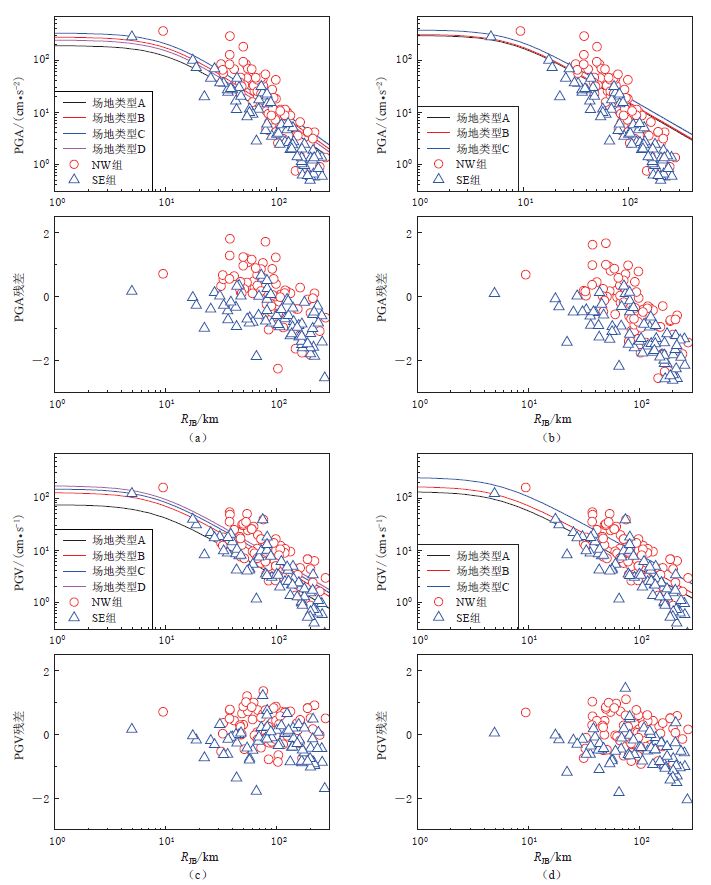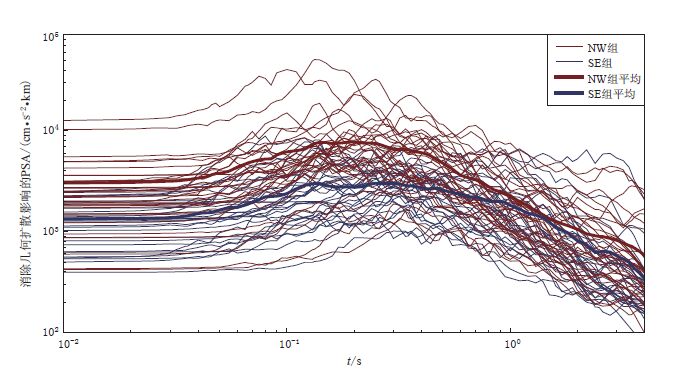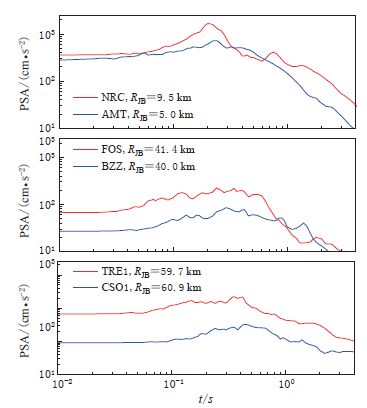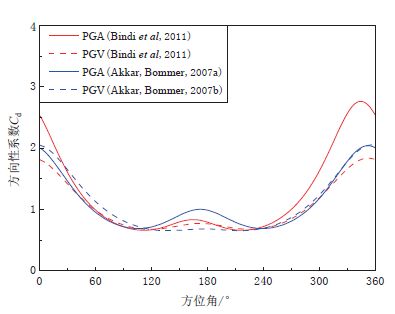Rupture directivity effect of near-field ground motions in Italy MW6.2 earthquake on August 24, 2016
-
摘要: 为研究2016年8月24日意大利中部MW6.2地震的断层破裂方向性效应, 依据断层走向将强震动观测台站划分为SE和NW两组, 比较两组记录的地面峰值加速度PGA、 地面峰值速度PGV、 拟加速度反应谱PSA和重要持时DSR. 结果显示: NW组观测到的PGA, PGV和PSA普遍大于SE组, PGA和PGV的观测值与预测值的残差随方位角变化明显; NW组观测到的DSR值整体小于SE组, 由此推断此次地震存在明显的方向性效应. 在此基础上, 采用反演方法, 确定了该地震的震源为双向非对称破裂, 主破裂方向大约介于345°—360°之间, 主破裂长度约占整个破裂的70%—80%, 破裂速度为2.2—2.5 km/s, 反演结果印证了两组台站数据的地震动参数差异是由断层破裂方向效应所引起的.
-
关键词:
- 意大利MW6.2地震 /
- 破裂方向 /
- 地震动参数 /
- 反演
Abstract: For investigating the rupture directivity effect of the central Italy MW6.2 earthquake on August 24, 2016, more than 150 strong motion stations are separated into two groups, which are SE and NW, according to the fault strike. Comparing the PGA, PGV, pseudo-acceleration response spectrum (PSA) and significant duration DSR of two groups, the results show that: the observed PGAs, PGVs and PSAs of NW group are larger than those of SE group; the residuals between the observed and predicted PGAs and PGVs are significantly correlated with the azimuth; the observed DSR of NW group is smaller than that of SE group. From these observations we deduce that the rupture directivity effect exists in this earthquake. Furthermore, the inversion for source rupture parameters using PGAs and PGVs, respectively, shows that the rupture is bilateral, and the MW6.2 earthquake predominantly ruptured in the direction 345°--360°, accounting for 70%--80% of the total rupture, and the rupture velocity is 2.2--2.5 km/s. These results validate the conclusion that the differences of ground motion parameters between two groups of stations might be caused by the rupture directivity effect.-
Keywords:
- Italy MW6.2 earthquake /
- rupture directivity /
- ground motion para-meter /
- inversion
-
引言
2013年4月20日8时2分, 四川省雅安市芦山县(30.3°N, 103.0°E)发生MS7.0地震, 地震震源深度13 km. 这是继2008年5月12日汶川特大地震之后龙门山断裂带又一次灾难性地震事件. 震中距成都约110 km, 距汶川大地震震中不足100 km. 截至4月28日8时, 共记录到余震5 531次, 其中MS≥3.0地震113次, 最大余震为MS5.4. 截至4月24日14时30分, 共造成196人遇难, 失踪21人, 11 470人受伤, 累计造成231余万人受灾(中国地震局, 2013a). 地震发生后, 中国地震局地球物理研究所立即启动应急响应, 地震现场工作队于当天上午出发奔赴灾区开展现场震害调查、 灾害损失评估等工作. 通过对芦山县、 天全县、 荥经县、 汉源县和石棉县的震害调查, 收集了灾区各种典型建筑结构的震害资料. 基于这些震害资料, 本文初步分析了这次地震中土木结构、 木结构、 砖木结构、 砖混结构、 砌体-框架混合结构及框架结构房屋的震害特征, 并结合典型建筑结构震害案例, 从抗震概念设计和抗震构造措施的角度对震害机理进行了探讨, 旨在为今后的建筑物抗震设计提供参考.
1. 房屋建筑震害特征
芦山地震发生在四川西部山区, 震中位于雅安市芦山县龙门乡、 宝盛乡、 太平镇交界, 距芦山县城只有10 km. 根据中国地震局发布的地震烈度图, 震中烈度高达Ⅸ度, 全部受灾面积约18 682 km2, 如图1所示. 由于当地经济相对比较落后, 多数民房破坏严重, 特别是偏远山区, 道路极不方便, 房屋多以土木和砖木结构为主. 有些房屋由于受汶川地震等因素影响, 还没有来得及重建或者加固, 在这次地震中破坏也很严重. 在汶川地震之后重建或者加固的房屋, 大多表现良好.
![]() 图 1 2013年4月20日四川省芦山MS7.0地震烈度图 (据中国地震局(2013b)2013年4月25日发布的烈度图修改)Figure 1. Seismic intensity map of Lushan, Sichuan, MS7.0 earthquake occurred on 20 April 2013 (revised after the seismic intensity map issued by China Earthquake Administration (2013b) on 25 April 2013)
图 1 2013年4月20日四川省芦山MS7.0地震烈度图 (据中国地震局(2013b)2013年4月25日发布的烈度图修改)Figure 1. Seismic intensity map of Lushan, Sichuan, MS7.0 earthquake occurred on 20 April 2013 (revised after the seismic intensity map issued by China Earthquake Administration (2013b) on 25 April 2013)震区房屋建筑的结构形式多种多样, 本文将其主要分为以下几类: 木结构、 土坯-木屋架结构、 砌体-木屋架结构、 砖混结构(包含砌体-框架混合结构)及钢筋混凝土框架结构. 此外, 芦山县人民医院的主楼, 是国内首个经历大地震检验的隔震建筑, 在震后受到广泛的关注, 本文将其单独列出加以分析. 下面分别介绍各类建筑的震害特征.
1.1 土坯-木屋架房屋
部分偏远山区, 如汉源县小堡藏彝族自治乡, 由于经济落后, 交通不便, 水泥、 砂石、 钢筋等运送很不方便, 绝大多数房屋仍然是以土坯墙为承重结构, 屋架大梁直接搭在横山墙上. 而且这样的房屋多数年代久远, 房屋土坯墙体底部大多已剥蚀严重, 墙体承载力低, 抗震性能较差. 虽然远离极震区, 但仍然受到不同程度的损害, 如墙体开裂、 木屋架塌陷等, 如图2所示.
1.2 木结构
由于木材可以就地取材, 相对造价较低, 在一些乡村, 木结构房屋还是一种比较常见的结构形式. 由于木结构房屋具有较好减震耗能连接方式, 如榫卯节点、 柱脚“平摆浮搁”以及斗拱等(潘毅, 王超, 2012). 在此次地震中, 多数这类房屋并未出现结构性损坏. 但这类房屋往往年代久远, 甚至上百年, 年久失修, 部分房屋出现梁柱歪斜, 屋面坍塌, 甚至完全倒塌的情况. 也有一些房屋内的隔墙使用砌体或者土坯, 由于与主体结构连接不够, 出现倾倒情况. 该类房屋的震害如图3所示.
1.3 砌体-木屋架结构
砌体-木屋架结构房屋采用砖墙承重, 屋面采用硬山搁檩, 檩条上直接铺瓦的结构形式; 无钢筋混凝土构造柱和圈梁. 这类房屋在灾区较为常见, 以民房居多. 由于没有抗震构造措施, 其抗震性能普遍较差, 加之为了节约成本, 农民自建房中很多采用“12”墙承重, 导致了该类房屋在这次地震中遭受了较为严重的破坏. 其震害主要表现为严重掉瓦、 屋架坍塌、 墙体严重开裂、 墙体倒塌等, 典型震害如图4所示.
1.4 砖混结构
地震区村镇的住宅、 教学楼、 医院, 城市的一些旧的居民楼、 办公楼多采用的砖混结构, 是震区非常常见的一种结构类型. 灾区的砖混结构墙体多采用烧结普通粘土砖, 也有个别使用混凝土小型空心砌块. 此次地震中, 该类型房屋的震害主要表现为承重墙及窗间墙的严重开裂(X形剪切裂缝)、 局部压碎或坍塌. 少数房屋出现完全倒塌的情况, 但也有相当一部分砖混结构由于墙体严重损坏已经不能再继续使用. 砖混房屋的震害如图5所示. 比较典型的破坏原因有: 墙体单薄, 承载力不足(承重墙有为数不少的“18”墙和“12”墙); 采用强度较低的石灰砂浆代替水泥砂浆砌筑; 未设置构造柱和圈梁, 开窗较大和较多, 结构整体性较差.
![]() 图 5 砖混结构震害. (a) 承重墙剪切裂缝; (b) 承重墙严重破坏; (c) 窗间墙剪切裂缝; (d) “18”厚承重墙局部垮塌; (e) 非承重墙外闪倒塌; (f) 毁坏的砌体结构Figure 5. Seismic damage of masonry buildings. (a) Shear cracks of bearing wall; (b) Serious damage of bearing wall; (c) Shear cracks of wall between windows; (d) Local collapse of 18 cm thick bearing wall; (e) Collapse of non-bearing wall; (f) Destroyed masonry building
图 5 砖混结构震害. (a) 承重墙剪切裂缝; (b) 承重墙严重破坏; (c) 窗间墙剪切裂缝; (d) “18”厚承重墙局部垮塌; (e) 非承重墙外闪倒塌; (f) 毁坏的砌体结构Figure 5. Seismic damage of masonry buildings. (a) Shear cracks of bearing wall; (b) Serious damage of bearing wall; (c) Shear cracks of wall between windows; (d) Local collapse of 18 cm thick bearing wall; (e) Collapse of non-bearing wall; (f) Destroyed masonry building1.5 砌体-框架混合结构
砌体-框架混合结构主要指底框砖混结构(竖向混合, 底部框架或者部分框架, 上部砖混), 也有部分框架-部分砖混(水平混合)的结构. 这类结构的体系大多比较混乱, 在这次地震中遭受了不同程度的损坏. 底框结构的底层往往作为商铺使用, 开间较大, 填充墙设置较少, 导致底层的抗侧刚度不足, 形成薄弱层, 在地震作用下极易发生破坏. 而对于部分框架-部分砖混的水平混合结构, 框架和砌体承重墙抗侧力构件的承载力和变形能力的不协调, 以及平面抗侧刚度的极不均匀都会加重震害. 砌体-框架混合结构的震害主要表现为底部框架由于变形集中在柱脚和梁柱, 节点处出现塑性铰, 底部填充墙出现严重剪切破坏甚至倒塌; 上部砌体结构的破坏. 图6所示为这类结构的主要震害情况.
![]() 图 6 砌体-框架混合结构震害. (a) 受损的底框结构; (b) 底层柱顶破坏; (c) 底层柱底破坏; (d) 底层柱中剪切裂缝; (e) 底层填充墙破坏; (f) 上部砌体结构破坏Figure 6. Seismic damage of masonry-frame hybrid buildings. (a) Damaged of bottom frame structure; (b) Damage of the top of column; (c) Damage of the bottom of column; (d) Shear crack at the middle of column; (e) Shear cracks of infill wall; (f) Damage of the masonry structure on the top
图 6 砌体-框架混合结构震害. (a) 受损的底框结构; (b) 底层柱顶破坏; (c) 底层柱底破坏; (d) 底层柱中剪切裂缝; (e) 底层填充墙破坏; (f) 上部砌体结构破坏Figure 6. Seismic damage of masonry-frame hybrid buildings. (a) Damaged of bottom frame structure; (b) Damage of the top of column; (c) Damage of the bottom of column; (d) Shear crack at the middle of column; (e) Shear cracks of infill wall; (f) Damage of the masonry structure on the top1.6 框架结构
在调查区域, 框架结构较为少见. 该类房屋一般都经过正规的抗震设计, 震害也较轻. 图7所示为汶川地震后重建的龙门乡街道上的框架结构, 只有极少数的填充墙出现轻微裂缝.
1.7 隔震结构
芦山医院综合楼采用了橡胶垫减震技术, 是震区唯一, 也是我国第一栋 经历地震检验的隔震建筑, 其全貌如图8a所示. 该建筑在此次地震中表现良好, 除局部个别墙体出现轻微裂缝外(图8b), 主体结构以及附属结构(门、 窗、 吊顶、 装饰等)均未出现损坏. 而与之相距不足100 m的芦山博物馆却遭受了更为严重的损伤(图8c). 值得注意的是, 由于加了减震技术的综合楼在地震作用下, 其整体侧向位移要大于一般结构, 从而导致了主楼与底层附属结构连接处发生损坏, 以及主楼与附属楼产生碰撞造成连接处门诊楼的梁柱发生破坏(图8d, e). 这是隔震结构在建造过程中需要注意的问题, 应在主体结构与周围附属结构之间设置一定的隔震措施, 防止由于主体结构过大的水平位移造成附属结构的破坏.
![]() 图 8 采用隔震结构的芦山医院在芦山地震中的表现. (a) 芦山医院全貌; (b) 填充墙轻微裂缝; (c) 医院对面芦山博物馆的震害; (d) 主楼与附属结构连接处的破坏; (e) 主楼与附楼连接处的破坏Figure 8. Seismic performance of isolated building. (a) Lushan Hospital; (b) Slight cracks on infill wall; (c) Damage of Lushan Museum opposite to Lushan Hospital; (d) Damage of connection between main building and attachment; (e) Damage of connection between main building and attached building
图 8 采用隔震结构的芦山医院在芦山地震中的表现. (a) 芦山医院全貌; (b) 填充墙轻微裂缝; (c) 医院对面芦山博物馆的震害; (d) 主楼与附属结构连接处的破坏; (e) 主楼与附楼连接处的破坏Figure 8. Seismic performance of isolated building. (a) Lushan Hospital; (b) Slight cracks on infill wall; (c) Damage of Lushan Museum opposite to Lushan Hospital; (d) Damage of connection between main building and attachment; (e) Damage of connection between main building and attached building2. 典型震害的原因分析
2.1 开窗对抗震性能的影响
与汶川地震中建筑结构的震害类似(熊立红等, 2008; 李小军等, 2008), 许多自建的砌体结构底层存在门窗面积过大、 开洞过多且位置不合适等问题, 这不仅会造成结构抗侧刚度的不足, 而且会导致应力集中现象, 加重墙体的破坏程度. 另外, 承重墙过多的开窗会使得窗间墙体形成“短柱”, 在地震作用下由于短柱效应极易出现剪切破坏. 不合理开窗造成的震害现象如图9所示.
![]() 图 9 不合理开窗造成的震害加重. (a) 承重墙不合理开窗; (b) 承重墙开窗过大; (c) 非承重墙开窗过大; (d) 墙体开窗过多造成短柱效应Figure 9. Inappropriate location of windows increasing the seismic damage. (a) Inappropriate location of windows on bearing wall; (b) Oversized window on bearing wall; (c) Oversized window on non-bearing wall; (d) Short column effect caused by excessive windows on the wall
图 9 不合理开窗造成的震害加重. (a) 承重墙不合理开窗; (b) 承重墙开窗过大; (c) 非承重墙开窗过大; (d) 墙体开窗过多造成短柱效应Figure 9. Inappropriate location of windows increasing the seismic damage. (a) Inappropriate location of windows on bearing wall; (b) Oversized window on bearing wall; (c) Oversized window on non-bearing wall; (d) Short column effect caused by excessive windows on the wall2.2 不规则结构的震害
我国建筑抗震设计规范对建筑体型均匀规整性有明确要求(中华人民共和国建设部, 2001), 历次地震的震害现象多次说明了体型均匀规整的重要性(温增平等, 2009; 李巨文等, 2013). 然而这种平面或者立面布置不规则的结构在灾区仍然非常常见, 震害往往都比较严重. 例如图10a所示的二层外挑的竖向不规则砖混结构在灾区尤为普遍, 这类建筑由于“头重脚轻”, 加之底层墙体普遍较少, 结构整体的竖向刚度存在突变, 很容易造成底层的严重破坏. 图10b所示为结构平面呈不规则多边形的砖混房屋, 这类房屋容易在扭转地震作用下出现严重的破坏. 图10c, d为平面呈“L”型, 竖向有质量和刚度突变的建筑; 由于传力途径不明确, 在复杂的地震作用下均遭受了严重的破坏, 已失去使用功能.
2.3 屋顶楼梯间和加层的震害
调查中发现, 一些建筑的楼梯间或者顶部加层相对于主体结构发生更为严重的破坏, 如图11所示. 这种屋顶突起物, 由于“鞭梢效应”会增加其地震反应, 容易出现较主体结构更明显的震害, 在房屋设计时应尽量避免. 图11d所示的屋顶局部加层的严重震害是值得关注的问题. 这种屋顶的局部加层往往缺乏与主体结构的有效连接, 不能与主体结构有效形成整体; 加之“鞭梢效应”的存在, 很容易出现墙体闪落甚至顶部结构垮塌的现象. 笔者曾经在调查玉溪市房屋建筑特征时发现大量此类屋顶加层的房屋, 对其抗震性能一直心存疑虑, 希望此次地震的经验教训可以为相关部门提供一定的参考价值.
![]() 图 11 突出屋顶的楼梯间和加层的破坏. (a) 屋顶楼梯间墙体开裂; (b) 屋顶楼梯间墙体开裂;(c) 屋顶楼梯间垮塌砸坏主体结构; (d) 屋顶加层结构发生墙体闪落Figure 11. Damage of outshoot roof staircases and adding story. (a) Wall cracking of outshoot roof staircases; (b) Wall cracking of outshoot roof staircases; (c) Damage of main structure caused by collapsed outshoot roof staircases; (d) Collapse of walls of adding story
图 11 突出屋顶的楼梯间和加层的破坏. (a) 屋顶楼梯间墙体开裂; (b) 屋顶楼梯间墙体开裂;(c) 屋顶楼梯间垮塌砸坏主体结构; (d) 屋顶加层结构发生墙体闪落Figure 11. Damage of outshoot roof staircases and adding story. (a) Wall cracking of outshoot roof staircases; (b) Wall cracking of outshoot roof staircases; (c) Damage of main structure caused by collapsed outshoot roof staircases; (d) Collapse of walls of adding story2.4 建筑之间的碰撞
由于不同相邻建筑结构形式, 其高度、 刚度和重量的不同, 在地震作用下, 往往结构运动不协调, 容易发生碰撞, 进而加重结构损坏. 例如图12所示为两栋高度不同的相邻建筑之间未采取任何防震措施, 由于相互碰撞造成了一定的破坏, 而与之相近的另外两栋建筑中间设置了一定的空间而未发生任何损坏. 这种现象在历次地震的震害中也比较多见, 应引起足够的重视, 在规划和设计时应采取相应措施以避免这种情况的出现.
3. 结论和建议
每一次大地震所造成的灾难都值得广大土木工程从业人员深思, 地震中各类建筑物的表现极大地丰富了人们对其抗震性能的认识. 本文通过对芦山MS7.0地震中房屋建筑的震害分析, 得到以下几点认识:
1) 由于当地经济相对落后, 自建民房以土木、 砖木等造价较低的结构为主. 此外, 为了节省成本, 许多承重墙厚度和砌筑砂浆不满足要求, 导致其抗震性能普遍较差. 随着我国经济的发展, 在资金充裕的前提下, 应选择更有利于抗震的结构形式, 逐步提高农村中自建民房的抗震能力.
2) 砖混结构和砌体-框架混合结构的抗震性能需要严格的抗震构造措施给予保证, 包括合理设置钢筋混凝土构造柱和圈梁, 合理设置承重墙的数量和开洞位置, 加强承重墙的安全储备, 以及选择规则的结构平面和竖向布置等.
3) 屋顶突起物及屋顶局部加层所形成的“鞭梢效应”, 以及相邻建筑物之间的相互碰撞都会加重震害, 在规划和设计时应采取相应的措施以避免以上情况的出现.
4) 为了提高经济落后地区建筑结构的抗震能力, 建议加强各级政府、 行政部门和普通群众的抗震防灾意识, 加强结构抗震体系和概念设计的教育, 并在抗震构造措施方面严格执行设计规范的规定. 对于农村自建住宅, 政府应组织专业技术人员给予指导, 合理选择结构形式并设置抗震措施, 以最大程度地减少因建筑物抗震能力不足倒塌破坏造成的人员伤亡和经济损失.
-
图 5 PGA(a,b)与PGV(c,d)观测值与预测值的比较及残差随RJB的变化图(a)和(c)的衰减曲线引自Bindi等(2011),图(b)和(d)的衰减曲线分别引自Akkar和Bommer(2007a)以及Akkar和Bommer(2007b)
Figure 5. Comparison of the observed PGAs(a,b)and PGVs(c,d)with predicted ones and their residuals varied with RJB Attenuation curves in Figs.(a)and(c)refer to Bindi et al(2011),those in Figs.(b)and(d)refer to Akkar and Bommer(2007a)and Akkar and Bommer(2007b),respectively
图 6 PGA(a,b)和PGV(c,d)观测值与预测值的残差随方位角变化的特征
图(a)和(c)中计算残差所用的预测值引自Bindi等(2011),图(b)和(d)中分别引自Akkar和Bommer(2007a)及Akkar和Bommer(2007b)
Figure 6. Variation of the residuals between the observed and predicted PGAs(a,b)and PGVs(c,d)with azimuth
The predicted values used for residual calculation in Figs.(a)and(c)refer to Bindi et al(2011),while those in Figs.(b)and(d)refer to Akkar and Bommer(2007a)and Akkar and Bommer(2007b),respectively
表 1 采用PGA和PGV反演得到的震源破裂参数
Table 1 Seismic source rupture parameters from inversion of PGAs and PGVs
预测方程 峰值参数 φ/° vr/c k Bindi等(2011) PGA
PGV344.8±20.3
352.4±10.90.71±0.09
0.59±0.10.8±0.13
0.75±0.13Akkar和Bommer(2007a,b) PGA
PGV356.6±21.0
352.5±4.70.6±0.09
0.66±0.030.82±0.11
0.69±0.04注:φ为破裂方向,vr/c为马赫数,k为初始破裂点的相对位置. -
胡进军, 谢礼立. 2011. 汶川地震近场加速度基本参数的方向性特征[J]. 地球物理学报, 54(10): 2581-2589. http://www.cnki.com.cn/Article/CJFDTOTAL-DQWX201110016.htm Hu J J, Xie L L. 2011. Directivity in the basic parameters of the near-field acceleration ground motions during the Wenchuan earthquake[J]. Chinese Journal of Geophysics, 54(10): 2581-2589 (in Chinese). http://www.baidu.com/link?url=CjvvQ2WWQLQdJ5QlgCIYsjciVRS6giw9PVrUBVXtP6aE5MlBdElg1oaGAW53160V4bFETznKTnUPwdE9Plu8nvgsq7QWJTiQ-HNClxuthOCtA97UK38U4GaDP5E1W3nIJOiKza_pK2PjxNRtL1sSWgabEKyS7Srifma7Fzzpc-EibQygyb9FJ3R5Bm5IP9wBjVe-eSyNUxy6AortnfSRZJA_czOB6TDbdA8SFTXQmp49xRVEQ8LjGPZ81XQjk3XuuV7qiy3oXjxqCFHal3G1VGcfDtha7KFbKrSE00j5cHtmjmOo1xlC4HE0AU7--E2EFErUYq7xCakodCe_qmCjXTN9JrBppoDKWkUdtVVqTLdro6Dkoa_milLBQswADVqNc1TeV92nXo9eeXpGpm_ef_&wd=&eqid=ba8928f0000326cc0000000558808c3a
任叶飞, 温瑞智, 周宝峰, 黄旭涛. 2014. 2013年4月20日四川芦山地震强地面运动三要素特征分析[J]. 地球物理学报, 57(6): 1836-1846. http://www.cnki.com.cn/Article/CJFDTOTAL-DQWX201406015.htm Ren Y F, Wen R Z, Zhou B F, Huang X T. 2014. The characteristics of strong ground motion of Lushan earthquake on April 20, 2013[J]. Chinese Journal of Geophysics, 57(6): 1836-1846 (in Chinese). http://www.baidu.com/link?url=SbfvbvlCFH6fqG30-_Ida6VrWL7VVxcAOzxjo_CMMp7AU-9NnkyefyHdB6s863VW0FXZqCQ4pj039W7BR2btdc1iKqHRoQltcfTCJnJ4hWhy8ypb-JyYNSDA6J8RjQw4kScGinLU0vlatCij4ddpC8HVmFzAfvbgUfzGYyMJtmQUi9hante-hGIE8-1Pxwtefrnb0kW3biN004AqMniPKRuLdosKQCGfNxEigv_SFuVIjw7Z7M1tWciyITNmOREahi8xLCa6JV7ZpXhwn_R_9ZFir4PFUIQ3W8ql8HeOzAIsy5F3zOEo85SM2EvKCcBCaCSWTKZ9soglLKXFsQn_gMmIitaIW3woxSDQzWcFaCy&wd=&eqid=b5e84e9600031f910000000558808c4f
Akinci A, Malagnini L, Sabetta F. 2010. Characteristics of the strong ground motions from the 6 April 2009 L’Aquila earthquake, Italy[J]. Soil Dyn Earthquake Eng, 30(5): 320-335. doi: 10.1016/j.soildyn.2009.12.006
Akkar S, Bommer J J. 2007a. Prediction of elastic displacement response spectra in Europe and the Middle East[J]. Earthquake Engng Struct Dyn, 36(10): 1275-1301. doi: 10.1002/(ISSN)1096-9845
Akkar S, Bommer J J. 2007b. Empirical prediction equations for peak ground velocity derived from strong-motion records from Europe and the Middle East[J]. Bull Seismol Soc Am, 97(2): 511-530. doi: 10.1785/0120060141
Amato A, Montone P. 1997. Present-day stress field and active tectonics in southern peninsular Italy[J]. Geophys J Int, 130(2): 519-534. doi: 10.1111/gji.1997.130.issue-2
Atkinson G M, Mereu R F. 1992. The shape of ground motion attenuation curves in southeastern Canada[J]. Bull Seismol Soc Am, 82(5): 2014-2031. http://cn.bing.com/academic/profile?id=15a8931a9c961362c995e8daaf233d5c&encoded=0&v=paper_preview&mkt=zh-cn
Benioff H. 1955. Mechanism and strain characteristics of the White Wolf fault as indicated by the aftershock sequence[G]//Earthquakes in Kern County, California During 1995. Calif Div Mines Bull, California: California State Mining Bureau: 171: 199-202.
Bertrand E, Duval A M, Régnier J, Azzara R M. 2011. Site effects of the Roio basin, L’Aquila[J]. Bull Earthquake Eng, 9(3): 809-823. doi: 10.1007/s10518-011-9254-6
Bindi D, Pacor F, Luzi L, Puglia R, Massa M, Ameri G, Paolucci R. 2011. Ground motion prediction equations derived from the Italian strong motion database[J]. Bull Earthquake Eng, 9(6): 1899-1920. doi: 10.1007/s10518-011-9313-z
Boatwright J. 2007. The persistence of directivity in small earthquakes[J]. Bull Seismol Soc Am, 97(6): 1850-1861. doi: 10.1785/0120050228
Bommer J J, Stafford P J, Alarcon J E. 2009. Empirical equations for the prediction of the significant, bracketed, and uniform duration of earthquake ground motion[J]. Bull Seismol Soc Am, 99(6): 3217-3233. doi: 10.1785/0120080298
Boore D M. 2004. Effect of baseline corrections on displacements and response spectra for several recordings of the 1999 Chi-Chi, Taiwan, earthquake[J]. Bull Seismol Soc Am, 91(5): 1199-1211. doi: 10.1785/0120000703
Comité Européen de Normalisation. 2003. Eurocode 8: Design of Structures for Earth[S].Brussels:Brusells Comite Europeen de Nromalisation:19-21.
Convertito V, Emolo A. 2012. Investigating rupture direction for three 2012 moderate earthquakes in northern Italy from inversion of peak ground-motion parameters[J]. Bull Seismol Soc Am, 102(6): 2764-2770. doi: 10.1785/0120120067
Convertito V, Caccavale M, De Matteis R, Emolo A, Wald D, Zollo A. 2012. Fault extent estimation for near-real-time ground-shaking map computation purposes[J]. Bull Seismol Soc Am, 102(2): 661-679. doi: 10.1785/0120100306
Frepoli A, Amato A. 1997. Contemporaneous extension and compression in the Northern Apennines from earthquake fault-plane solutions[J]. Geophys J Int, 129(2): 368-388. doi: 10.1111/gji.1997.129.issue-2
Ghisetti F, Vezzani L. 1981. Contribution of structural analysis to understanding the geodynamic evolution of the Calabrian arc (Southern Italy)[J].J Struct Geol, 3(4): 371-381. doi: 10.1016/0191-8141(81)90037-7
Ghisetti F, Vezzani L. 2002. Normal faulting, transcrustal permeability and seismogenesis in the Apennines (Italy)[J]. Tectonophysics, 348(1/2/3): 155-168. http://cn.bing.com/academic/profile?id=e8d8fd70912ba5d40cd3a129fc889ad0&encoded=0&v=paper_preview&mkt=zh-cn
INGV. 2016. Modello preliminare di distribuzione dello spostamento sulla faglia dai dati ALOS2, Sentinel 1 e GPS in continuo[EB/OL]. [2016-08-30]. https://ingvterremoti.wordpress.com/2016/08/30/.
Orfeus. 2016. ESM: Engineering strong-motion database[EB/OL]. [2016-08-30]. http://esm.mi.ingv.it/DYNA-stage/CadmoDriver?_action_do=1&_page=ACC_redirect_home_page&_rock=INVALID&_state=initial&_tabber=0&_token=NULLNULLNULLNULL.<
Savelli C. 1988. Late Oligocene to Recent episodes of magmatism in and around the Tyrrhenian Sea: Implications for the processes of opening in a young inter-arc basin of intra-orogenic (Mediterranean) type[J]. Tectonophysics, 146(1/2/3/4): 163-181. http://cn.bing.com/academic/profile?id=59e77f4d5a8ac31a36bb73a1cd2752fc&encoded=0&v=paper_preview&mkt=zh-cn
Seekins L C, Boatwright J. 2010. Rupture directivity of moderate earthquakes in northern California[J]. Bull Seismol Soc Am, 100(3): 1107-1119. doi: 10.1785/0120090161
Somerville P G, Smith N F, Graves R W, Abrahamson N A. 1997. Modification of empirical strong ground motion atte-nuation relations to include the amplitude and duration effects of rupture directivity[J]. Seismol Res Lett, 68(1): 199-222. doi: 10.1785/gssrl.68.1.199
Trifunac M D, Brady A G. 1975. A study on the duration of strong earthquake ground motion[J]. Bull Seismol Soc Am, 65(3): 581-626. http://cn.bing.com/academic/profile?id=e926e5a933c0321fd4a3ba4c278c4773&encoded=0&v=paper_preview&mkt=zh-cn
USGS. 2016. Moment tensor[EB/OL]. [2016-08-30]. http://earthquake.usgs.gov/earthquakes/eventpage/us10006g7d#moment-tensor.
Wen R Z, Wang H W, Ren Y F. 2015. Rupture directivity from strong-motion recordings of the 2013 Lushan aftershocks[J]. Bull Seismol Soc Am, 105(6): 3068-3082. doi: 10.1785/0120150100
-
期刊类型引用(7)
1. Yan Zhaolun,Peng Xiaobo,Li Shuguang,Hong Haichun. Characteristics and Analysis of the Seismic Damage from the M_S7.0 Jiuzhaigou Earthquake in the Area between Songpan and Jiuzhaigou. Earthquake Research in China. 2018(02): 173-188 .  必应学术
必应学术
2. 赵文哲,温增平,徐超,陈波. 楼层侧向刚度比对砌体结构地震易损性的影响分析. 震灾防御技术. 2018(04): 878-892 .  百度学术
百度学术
3. 潘毅,袁双,谢丹,高永昭. 我国震后建筑安全性应急评估现状与建议. 土木工程学报. 2017(05): 19-26 .  百度学术
百度学术
4. 鄢兆伦,彭小波,李曙光,洪海春. 九寨沟7.0级地震松潘至九寨沟震害特征及分析. 中国地震. 2017(04): 626-638 .  百度学术
百度学术
5. 方杰,秦小军,蔡永建,王秋良,雷静雅. 基于DDA和FEM的砌体结构震动分析. 大地测量与地球动力学. 2016(06): 520-524 .  百度学术
百度学术
6. 吴迪,霍维刚,周福霖. 采用GFRP橡胶隔震技术的某砌体结构动力响应分析. 广州大学学报(自然科学版). 2015(06): 45-49 .  百度学术
百度学术
7. 熊焱,吴迪,崔杰. 抗震规范中隔震装置的地震风险分析. 振动与冲击. 2015(13): 109-114 .  百度学术
百度学术
其他类型引用(12)





 下载:
下载:











